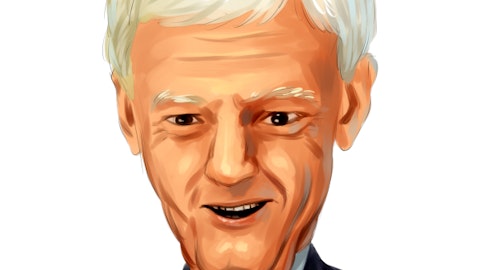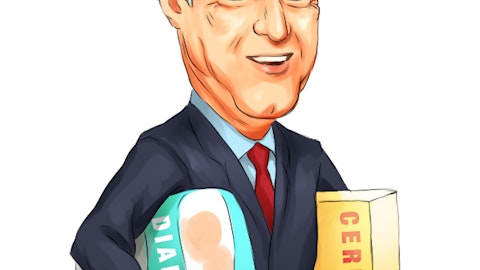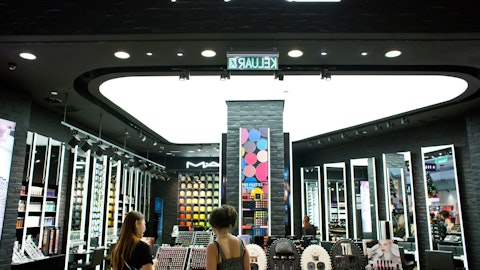Rod Little: Thank you, Olivia. Operator, next question, please.
Operator: The next question is from Bill Chappell with Truist Securities. Please go ahead.
Bill Chappell: Thanks. Good morning.
Rod Little: Good morning, Bill.
Bill Chappell: I guess two questions. One back on women’s in the U.S. What’s kind of the line of sight in the, I guess, beyond Walmart in terms of shelf space gains for this year? And do you think you can move — have the summer type move for Billie in terms of total share? Are we narrowing the gap further with where you are at Walmart? Or is it less of a share gain that we saw last year?
Rod Little: Bill, I think just relative to last year, less of a share gain, just given what’s already in the base now. But as it relates to billing and distribution, there’s some additional incremental distribution coming online this year around some of the regional players. All the big ones are covered. We’re effectively national, but there’s a little more fill-in to come. And then there’s a couple of channels that channel specifically that we’ve just turned on an online and then there’s always the club opportunity potentially out there for incremental distribution and coverage. And then we think the bigger play over time beyond shape is really realizing that the opportunity around a broader lifestyle brand and playing a much broader portfolio beyond shave, which we think the brand has the right to do.
Bill Chappell: So is there a plan to step up marketing advertising behind Billie this year now that you are kind of on a national platform or that’s been building through all last year anyways?
Rod Little: You will see an increased investment behind Billie this year that starts effectively now.
Bill Chappell: Got it. And then one follow-up on the Fem Care. Rod, I mean, I understand you have a new strategy in working on that. But Fem Care seems to have had probably 10 different new strategies over the past 15, 20 years of followed it. So I mean what gives you confidence that kind of volumes can stabilize again or actually grow?
Rod Little: Yes. This is not a new strategy, Bill, with what’s happening on Carefree. This is part of the strategy put in place a couple of years ago with a new dedicated team in place to do that. We’ve had clarity of strategy and consistency, I think, of execution against that strategy, which was, first, just stabilize the business, take some cost out, stabilize the business. We very much now moved into the phase of building better innovation, product performance, focused around claims, better product formulation, better targeting of who we’re talking to. So that’s where we are in the phase of the journey. You’re rightly pointing out, I think, Billie, a question or what could be a concern of what’s really going on and can we be successful in fem care?
Let me start by saying, I completely believe we can be successful in fem care, and we will be successful in fem care and that we can maintain unit volume growth at least in line with category or ideally ahead of category over time, right? So you’ve had what’s traditionally been a low single-digit growth category. And if you hold share within that position, you’re going to grow low single digits all else being equal. We’re coming off a period since the beginning of the pandemic where this category has been disrupted. If you go back to day one of the pandemic, fem care, that was one of the shelves that emptied out at the very beginning. We had supply disruptions, we, the category, not just us, the competitive set. And as recently as in the period we just lapped a year ago, we had competitors out of stock where we were benefiting from that position because we were in stock, which drove the double-digit growth in the period a year ago.
we’re lapping that today. So when you take year ago growth with where we are today, we’re actually at that low single-digit growth place on a 2-year stack basis in the quarter just finished. The good news for us all, I think it will be less messy going forward, because I think a lot of that is behind us in the category. And what we now cycle for our Q2, three and four is much more like-for-like, where consumption and our reported sales trends ought to match in a much closer way not only for us but also for competition as we go forward. I hope that helps.
Bill Chappell: That does. Thanks for the color.
Rod Little: You bet. Thank you, Bill. Operator, next question please.
Operator: The next question is from Chris Carey with Wells Fargo Securities. Please go ahead.
Chris Carey: Hi, good morning. So just two questions, but I wanted to start with gross margin. So if I adjust the gross margin for the inventory impact this quarter, obviously, the underlying run rate was quite a bit higher, closer to 46% gross margin. It sounds like, obviously, there was quite a bit of pull forward. But you’re also implying, I guess, roughly 43% gross margins for the rest of the year. What’s really driving that step down sequentially? Is that all productivity? Do you expect mix to get worse? Maybe thoughts on inflation? So just contextualizing why the underlying run rate steps down would be helpful. And then I have a follow-up.
Dan Sullivan: Chris, thanks for the question. Look, I think we have to put Q1 in proper context for what’s structural versus what’s timing, which I think I did in the previous question. But I think if you look at the elements that underpin the margin Q1, we expect would likely be our strongest quarter for productivity savings, our strongest quarter for price realization. That’s not to say that those won’t drive quarters two through four, but the impact will be less. And so you’ll start to see that scale down. Again, partly that is timing but also partly that is just structural, the way productivity and pricing are profiled in. Equally, though, you will see inflation continue to ease, maybe at a bit of a slower rate over time.
And so I think when you put all of that together, I would summarize it this way. I think we’re super encouraged about the way the team executed and the gains that we saw in the quarter. We’re hesitant to use Q1 as a proxy for the full year given some of the timing dynamics and the way productivity and price will phase back half of the year. We’re certainly confident as we look at our full year outlook in terms of the margin profile that we laid out, which was essentially 100 basis points constant currency gain.
Chris Carey: Okay. That’s helpful. regarding organic sales growth for the year, there’s a lot of moving pieces between strength in international markets, declines in North America this quarter. Obviously, Wet Shave had a very strong quarter, offset by Sun Care with kind of Sun and Skin being kind of maybe more neutral in the quarter. How do we frame the way that you’re viewing the business for the rest of the year? I don’t know if you can maybe offer some comments for expectations by segment, perhaps some expectations by international versus North America? I’m just conscious that you were talking about mix impact in gross margin in the quarter and maybe that changes go forward. So just — can you maybe just offer a bit more context on the complexion of the top line between international North America and some of our segments for the rest of the year? That would be helpful. Thanks.
Rod Little: Yes, Chris, good morning, it’s a good question because there’s a lot going on but we try to make it very, very simple. Last year, our international business outgrew our domestic U.S. business, let’s call it, approximately double the rate. I would expect that to be about where we land this year. All else being equal in terms of — if you look on a full year basis, we have international growing ahead of our domestic U.S. business as we kind of look at it together. What you saw in quarter one on the U.S. business is by no means a proxy of what we exceed the North America as we reported. As a proxy going forward, I would expect to see sequential improvement in our North American business throughout the balance of the year, largely because the innovation to come is domestically mostly here.
We know we have better planogram outcomes around distribution outcomes in the balance of the year. And so I think as we look at how the year sets up, particularly as you normalize for fem care which was half of the Q1 delivery under delivery. As that normalizes, that kind of takes care of itself. So I think you’ll see a better North American performance in the balance of the year. I think you’ll see the strength in international continue, albeit not at the absolute rate of growth we saw in the first quarter. And depending on weather, you ought to see a pretty resilient sun category. Shave, we think, continues to be on growth for us for the full year. And you’ll see, again, I think, sequential improvement in both Grooming and fem care, as we cycle forward here through the balance of the year.
Dan, I don’t know if you could clarify or add anything?
Dan Sullivan: No, just maybe to put some context to it, Chris. We still think that the 3% midpoint on organics is largely how it will phase by quarter. So we don’t necessarily anticipate a change there. And on the segment piece, we still anticipate sort of mid- to high single-digit growth on the right to win portfolio and low single-digit growth on the right to play portfolio.
Chris Carey: Okay. That’s helpful. Thank you.
Rod Little: Thanks, Chris. Operator, next question, please.
Operator: The next question is from Susan Anderson with Canaccord Genuity. Please go ahead.
Susan Anderson: Hi, good morning. Nice job on the quarter. I wanted to ask on the Men’s Grooming. I think sales were slightly down, but I think you noted that Bulldog was up. Maybe if you could give a little bit more color on the drivers there and what drove that growth, both domestic and international. Then also I’m curious if you have any new products coming out in the category for the year.




